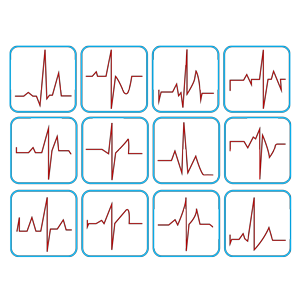Just curious, why does Squad 51 always send "lead 2" to Rampart - I assume there is a particular reason it's a better one?
You are using an out of date browser. It may not display this or other websites correctly.
You should upgrade or use an alternative browser.
You should upgrade or use an alternative browser.
Emergency Expert
- Thread starter Coldclay
- Start date
When I took my training it was best explained similar to this:
Lead II is the most common, most popular, and generally the best view because the placement of the positive electrode in Lead II views the wavefront of the impulse from the inferior aspect of the heart, as it travels from the right shoulder (RA) towards the left leg (LL). This view is in line with the mean electrical vector of the impulse that originates in the SA node, moving toward the Purkinje fibers.
By setting the EKG monitor to Lead II, we are essentially viewing the impulse as it travels from the right atria toward the left ventricle; hence, Lead II is the “best seat in the house” for viewing the wavefront. On a telemetry unit, you will see most, if not all monitors are set to Lead II for this reason.
Transmitting was actually more difficult than Emergency! implied at least in my area - think wide open spaces and using a 12-watt radio.
Sources: https://www.emsaware.org/articlesforems/ekgspatho

 calmedtrainingcenter.com
calmedtrainingcenter.com
Lead II is the most common, most popular, and generally the best view because the placement of the positive electrode in Lead II views the wavefront of the impulse from the inferior aspect of the heart, as it travels from the right shoulder (RA) towards the left leg (LL). This view is in line with the mean electrical vector of the impulse that originates in the SA node, moving toward the Purkinje fibers.
By setting the EKG monitor to Lead II, we are essentially viewing the impulse as it travels from the right atria toward the left ventricle; hence, Lead II is the “best seat in the house” for viewing the wavefront. On a telemetry unit, you will see most, if not all monitors are set to Lead II for this reason.
Transmitting was actually more difficult than Emergency! implied at least in my area - think wide open spaces and using a 12-watt radio.
Sources: https://www.emsaware.org/articlesforems/ekgspatho

To Which Lead View Should We Set The ECG Monitor? - California Medical Training Center
Share the love
 calmedtrainingcenter.com
calmedtrainingcenter.com
EKG’s have a possible 12 leads, each showing different views of the heart and its electrical conductivity. Lead 2 offers the best all around performance of the heart and is still the most used lead in prehospital care.Just curious, why does Squad 51 always send "lead 2" to Rampart - I assume there is a particular reason it's a better one?
Thanks so much for the head ups.When I took my training it was best explained similar to this:
Lead II is the most common, most popular, and generally the best view because the placement of the positive electrode in Lead II views the wavefront of the impulse from the inferior aspect of the heart, as it travels from the right shoulder (RA) towards the left leg (LL). This view is in line with the mean electrical vector of the impulse that originates in the SA node, moving toward the Purkinje fibers.
By setting the EKG monitor to Lead II, we are essentially viewing the impulse as it travels from the right atria toward the left ventricle; hence, Lead II is the “best seat in the house” for viewing the wavefront. On a telemetry unit, you will see most, if not all monitors are set to Lead II for this reason.
Transmitting was actually more difficult than Emergency! implied at least in my area - think wide open spaces and using a 12-watt radio.
Sources: https://www.emsaware.org/articlesforems/ekgspatho

To Which Lead View Should We Set The ECG Monitor? - California Medical Training Center
Share the lovecalmedtrainingcenter.com
Pretty much, Lead II usually gives a good positive amplitude to the P wave which is essential for diagnosing rhythm and blocks. Also, the R wave amplitude in Lead II is usually among the best of the leads so it's used for triggering the QRS sensing algorithm in monitors that gives a pulse rate readout.When I took my training it was best explained similar to this:
Lead II is the most common, most popular, and generally the best view because the placement of the positive electrode in Lead II views the wavefront of the impulse from the inferior aspect of the heart, as it travels from the right shoulder (RA) towards the left leg (LL). This view is in line with the mean electrical vector of the impulse that originates in the SA node, moving toward the Purkinje fibers.
By setting the EKG monitor to Lead II, we are essentially viewing the impulse as it travels from the right atria toward the left ventricle; hence, Lead II is the “best seat in the house” for viewing the wavefront. On a telemetry unit, you will see most, if not all monitors are set to Lead II for this reason.
Transmitting was actually more difficult than Emergency! implied at least in my area - think wide open spaces and using a 12-watt radio.
Sources: https://www.emsaware.org/articlesforems/ekgspatho

To Which Lead View Should We Set The ECG Monitor? - California Medical Training Center
Share the lovecalmedtrainingcenter.com
